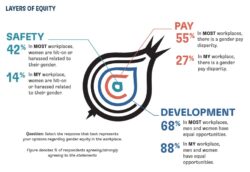Closing the gender gap in APAC: Elevating the system, not women
- HRM Asia Newsroom

“Beyond organisational efforts, women must also take proactive steps to bridge the gender gap. They should actively advocate for their own needs by requesting the autonomy and support necessary for growth, and pursuing assignments that align with their strengths.” – Centre for Creative Leadership (CCL).
Despite increased focus and investment in the Asia Pacific (APAC) workforce, women continue to face significant barriers to advancement in the next role. Hidden gaps stemming from unaddressed biases against women result in inequities such as lower pay, fewer opportunities for career progression, discriminatory practices, and gender bias.
These persistent challenges hinder women’s progress in the workplace, limiting their potential and contributions. In fact, according to the World Economic Forum it will now take 149 years to close the gender gap in South Asia and 189 years to close the gender gap in East Asia and the Pacific region. As such, there is an urgent need for individuals and organisations to act and elevate the system to achieve equity.
Examining the current challenges women faces
Many leaders may believe their organisation is free from gender equity issues, but a closer examination often reveals underlying problems. According to the Center for Creative Leadership’s (CCL) ‘Elevate the System’ report in 2024, it was revealed that there are five key challenges that need to be addressed:
- The struggle to get more women into senior roles, despite increased focus and investment on women in leadership.
- The additional obstacles women face on the path to leadership.
- How women’s innate leadership strengths can lead them to burn out at a faster rate.
- Women’s reluctance to ask for the challenging job assignments and increased exposure that propel careers forward.
- The systemic barriers that hold women back.
Using an onion peel analogy, 68% of leaders believe that equal development is available for men and women (surface level), but a deeper analysis reveals a different story. A high 55% of leaders acknowledge the existence of a gender pay gap in many workplaces (second layer), and a significant 42% recognise the presence of gender-related harassment (deeper layer). These findings highlight areas where significant progress is needed to create a truly equitable work environment.
Organisations must develop strategies for gender equity
To foster an equitable work environment, organisations should lay the groundwork by setting clear guidelines to support women aspiring to take on leadership positions over the next five to 10 years. This involves making systematic changes, such as cultivating a culture that embraces diversity and developing a strategic plan to achieve equity.
It is important to measure women’s representation and participation in more holistic ways, extending beyond high level quotas and targets. This involves evaluating their impact, influence, and opportunities at various organisational levels to ensure a fuller picture of their roles and contributions.
Additionally, elevating and recognising both men and women who actively champion women leaders is essential. One way to do so is to highlight their efforts in high-profile forums. We should not only acknowledge their contributions but also set a positive example that can inspire broader support for gender equity.
Investing in leadership development is also vital. Structured sponsorship, alongside traditional mentoring, should be a key component of training programmes. This approach ensures that women receive the necessary advocacy and support to advance their careers effectively, helping to bridge the gap between potential and achievement.
Women leaders need to speak up
Beyond organisational efforts, women must also take proactive steps to bridge the gender gap. They should actively advocate for their own needs by requesting the autonomy and support necessary for growth, and pursuing assignments that align with their strengths.
Moreover, it is vital to speak up when encountering systemic barriers or witnessing others in the “double-bind”. “Double-bind” is a phenomenon where women leaders are subjected to conflicting expectations: to be caring, sensitive and rule-following. And yet, when they embody these traits, they are often seen as too soft and “not good leaders”. Conversely, when women conform to leadership roles, they are perceived as “not good women” because these roles are stereotypically associated with assertiveness and authority, traits that contradict traditional feminine norms of nurturing and submissiveness. As such, addressing these issues openly in the workplace and asking for the necessary support helps prevent the need for excessive compromise or “double-flexing”, fostering a more equitable work environment for all women.
Setting up a workforce with allies
Organisations should play an active role in the workplace by creating opportunities for senior employees to develop a “mentorship” and “sponsorship” relationship with their juniors. By creating such an environment, it supports career growth and helps navigate systemic barriers, contributing to a more inclusive and equitable workplace. Mentors provide guidance and support by listening to their mentees’ experiences and give constructive, direct, and honest feedback. Sponsors, on the other hand, actively advocates “sponsoree” by promoting their accomplishments, connecting them to others in their network, pushing them to take on challenging assignments and recommending them for bigger opportunities.
74% of women surveyed in the same report feel that men in their company are taking action to support women leadership development, which is a positive sign. Notably, Indonesia constitutes a significant proportion of this percentage, with 90% of women citing supportive actions from men in their organisations; Only 63% of women in Singapore reported similar support, while in Australia, the figure stands at 62%. The reality is that people who can create opportunities for others often hold senior positions, making sponsors particularly important for women. While women commonly have mentors, they frequently lack sponsors, people who advocates for them and facilitates their career growth, making it important for organisations to create a culture that fosters women allyship.
Ultimately, achieving true equity requires commitment from both individuals and organisations. While it is crucial to avoid reverse discrimination and ensure that men retain equal opportunities in the workplace, addressing decades of disparity demands substantial systemic changes. These changes can only succeed if leaders are fully supportive and engaged at all levels of the organisation.
About the author: This article is written by the Centre for Creative Leadership (CCL), a global non-profit provider of leadership development.
For more news and analysis on the latest HR and workforce trends in Asia, subscribe to HRM Asia and be part of the region’s largest HR community!







